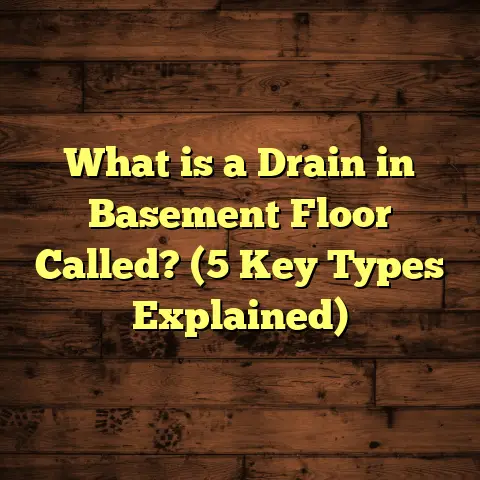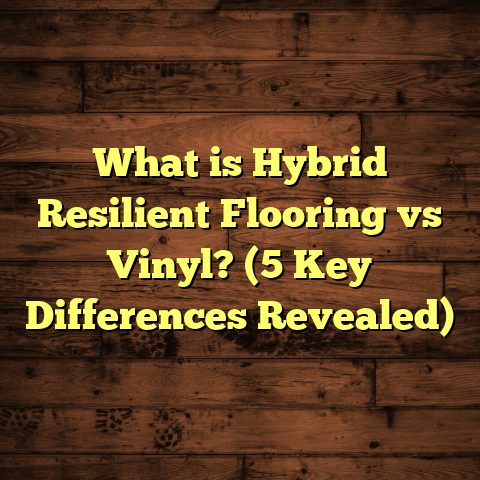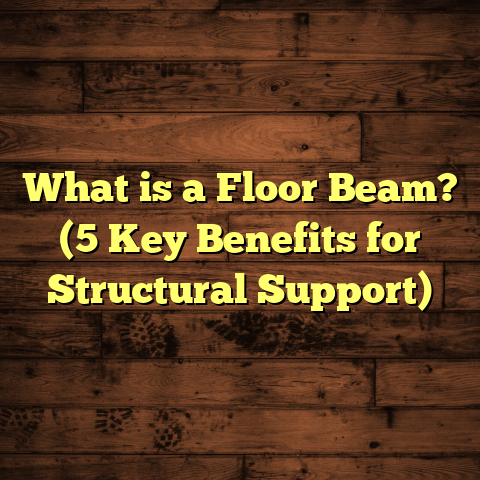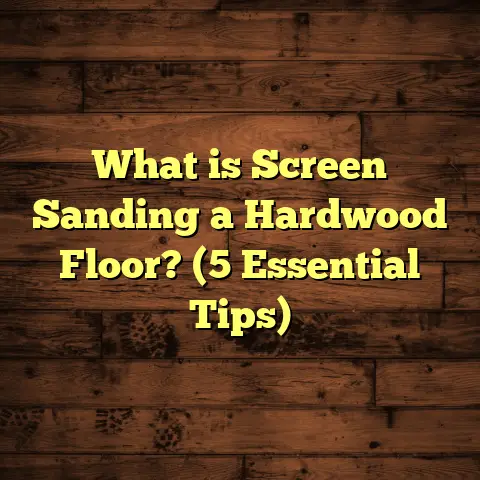What is Engineered Hardwood Floor? (5 Key Benefits Revealed)
Tapping Into Seasonal Trends: Why Engineered Hardwood Flooring Is Gaining Popularity Right Now
Have you noticed how the seasons influence our home choices? As the weather cools down, I often see a surge in calls from homeowners wanting to refresh their living spaces with something warm and inviting—floors being a prime focus. This time of year, engineered hardwood flooring pops up more than ever in conversations. It’s got that cozy look of real wood but handles the ups and downs of temperature and humidity like a champ.
But before jumping in, you might be wondering: what exactly is engineered hardwood? And why do so many people, including myself, recommend it? Over the years, I’ve installed hundreds of floors and seen firsthand how this material holds up. Let me walk you through the ins and outs of engineered hardwood flooring, share some data-backed insights, personal stories, and practical advice that might help you decide if it’s right for your home.
What Exactly Is Engineered Hardwood Flooring?
At its core, engineered hardwood is a multi-layered wood flooring product designed to offer the appearance of traditional hardwood with improved stability. Unlike solid hardwood, which is made from a single piece of wood throughout its thickness, engineered hardwood consists of several layers.
The top layer is a thin slice of genuine hardwood veneer—this could be oak, maple, walnut, or any other species you’d find in solid wood flooring. Underneath this veneer are multiple layers of plywood or high-density fiberboard (HDF), arranged so that the grain of each layer runs perpendicular to the one above it. This cross-layering technique dramatically improves dimensional stability.
I remember when I first encountered engineered hardwood about 15 years ago. Back then, it was mostly an option for spaces where solid hardwood wasn’t practical—like basements or kitchens. Over time though, the quality improved so much that it became a preferred choice for many rooms.
The technical side is interesting but what really matters is how this construction impacts everyday life. The layering helps prevent warping and cupping caused by moisture or temperature swings. So if you live somewhere with cold winters and humid summers, engineered hardwood can save you headaches.
Layers Breakdown
To get a clearer picture:
- Top layer (wear layer): Real hardwood veneer, thickness ranges from about 0.6 mm up to 6 mm.
- Core layers: Usually plywood or HDF with grains running perpendicular to each other.
- Bottom layer: Stabilizing layer to balance out the plank and prevent cupping.
This multi-ply design means engineered hardwood has less movement than solid wood when exposed to moisture changes.
1. Stability That Lasts: Why This Matters
You might ask: why does stability matter so much? Well, wood is a natural material that expands and contracts with changes in humidity and temperature. If you’ve ever noticed gaps opening between floorboards during dry winter months or boards swelling in summer, you’ve seen this effect in action.
Solid hardwood can be tricky because it’s a single piece of wood that reacts directly to moisture content changes. Engineered hardwood’s layered structure counters this by limiting movement.
In my experience working in different climates—from dry deserts to humid coastal towns—I’ve seen engineered hardwood outperform solid wood in terms of staying flat and secure.
One particular case stands out: a client living near the ocean had a home prone to humidity spikes. They installed solid oak floors initially but faced constant warping issues. When we replaced them with engineered hardwood, those problems disappeared. The floors held up great even when outdoor humidity rose above 80%.
According to the National Wood Flooring Association (NWFA), engineered hardwood can handle up to 50% more moisture variation than solid wood before showing signs of damage.
Why Moisture Resistance is Critical
When thinking about flooring durability, moisture resistance isn’t just about water spills from kids or pets. It’s about everyday environmental factors like:
- Seasonal humidity shifts
- Home heating and air conditioning cycles
- Basement or below-grade installation areas
- Radiant heating systems
Engineered hardwood’s ability to adapt without warping reduces repair costs and extends the life of your floors.
2. Easier Installation Saves Time and Money
If you’ve ever installed solid hardwood yourself or hired someone to do it, you know it can be a major project. Traditional solid hardwood often needs to be nailed down into a wooden subfloor, which requires prep work and skill.
Engineered hardwood offers more installation flexibility:
- Can be nailed, stapled, glued down, or floated over existing flooring.
- Works well over concrete slabs or radiant heating systems.
- Floating floors require no adhesive or nails—planks lock together using tongue-and-groove edges or click systems.
On one project in an older home with uneven subflooring, we chose floating engineered hardwood. It saved time because we didn’t have to level the floor perfectly or remove all the old tile beneath. The homeowner was thrilled with both the quick turnaround and minimal disruption.
Industry reports suggest floating installations can reduce labor time by around 30% compared to traditional nail-down methods. For contractors like me, that means I can offer competitive pricing and complete jobs faster without compromising quality.
Installation Types Explained
- Nail-down: Planks nailed into wooden subfloor.
- Glue-down: Adhesive applied directly to concrete or plywood.
- Floating: Planks lock together and “float” above existing floor.
Each method has pros and cons depending on your home’s structure and your budget.
3. Real Wood Beauty Without the Real Wood Worries
One reason many people opt for engineered hardwood is that it looks like the real deal—and it is! The wear layer is actual hardwood veneer, so you get authentic grain patterns, colors, and textures.
When I help clients pick flooring samples, they often run their hands across engineered wood planks and comment on how natural they feel compared to laminate or vinyl alternatives.
Modern manufacturing has improved veneer thickness too. It used to be thin enough that sanding wasn’t recommended or only possible once. Now you can find veneers up to 4 mm thick, allowing multiple sandings over the floor’s lifetime.
This means scratches or dents aren’t necessarily permanent. I once refinished an engineered floor three times over 12 years for a family who wanted to keep their floors looking fresh without replacing them.
How Does Refinishing Work?
- Thicker veneers (around 3-4 mm) can handle 2-3 sandings.
- Thinner veneers (less than 2 mm) generally aren’t sanded.
- Refinishing restores appearance and helps remove surface damage.
4. Budget-Friendly Without Sacrificing Quality
Money talks. When clients ask about cost differences between solid and engineered hardwood, I like to share actual figures from my projects.
Here’s what I’ve seen over hundreds of installs across various regions:
| Flooring Type | Average Installed Cost (per sq ft) |
|---|---|
| Solid Hardwood | $8 – $15 |
| Engineered Hardwood | $7 – $12 |
| Laminate | $3 – $6 |
| Vinyl Plank | $2 – $7 |
Engineered hardwood usually falls between laminate and solid wood in price but offers the look and longevity closer to solid wood.
For example, a recent client with a 1,200 sq ft space saved roughly $4,000 choosing engineered oak over solid oak while getting authentic wood floors with better moisture resistance.
And don’t forget labor savings—faster installation methods for engineered floors reduce overall project costs.
5. Environmentally Friendly Choice That Makes a Difference
Sustainability is increasingly on homeowners’ minds—myself included. Engineered hardwood helps reduce environmental impact by using less slow-growing hardwood per plank.
Only the top veneer layer uses premium hardwood species; the core layers often consist of fast-growing woods like poplar or recycled wood fibers. Many manufacturers also follow responsible forestry practices certified by groups like FSC (Forest Stewardship Council).
A recent report from FSC estimates that engineered flooring reduces demand for precious hardwood by about 40% compared to solid wood floors.
If you care about preserving forests but want real wood aesthetics, engineered flooring strikes a good balance between beauty and eco-consciousness.
Personal Stories From the Field
I’ve been lucky enough to work on diverse projects—from urban condos to lakeside cabins—and I’ve noticed some patterns worth sharing:
Story #1: The Coastal Cottage Challenge
Humidity near the ocean wreaks havoc on traditional wooden floors. A couple I worked with had constant issues with their original solid pine floors cupping badly every summer.
We replaced them with engineered white oak featuring a thick wear layer. After two years, they told me no signs of warping or gaps appeared despite seasonal humidity changes hitting above 75%. This saved them money on ongoing repairs and gave their home a fresh look.
Story #2: Basement Beauty
Basements are notorious for moisture problems that make solid wood floors risky. One homeowner chose engineered hickory for their finished basement media room.
The flooring installed over a vapor barrier stayed stable through wet springs and cold winters without swelling or mold issues—a common problem with carpets or solid wood in such spaces.
Story #3: Busy Family Home
Kids + pets + hardwood floors = potential disaster? Not always! A family with three energetic children opted for engineered maple with a durable finish.
After four years and countless spills, scrapes, and pet accidents, they reported minimal wear and easy cleaning. The ability to refinish in future years was a big selling point for them too.
How Does Engineered Hardwood Compare With Other Popular Flooring?
If you’re exploring flooring options beyond solid wood or engineered hardwood, here’s a quick rundown of key differences:
| Feature | Engineered Hardwood | Laminate | Vinyl Plank |
|---|---|---|---|
| Material | Real wood veneer + plywood/HDF | Fiberboard + photographic layer | PVC/plastic composite |
| Appearance | Authentic wood grain | Wood look but artificial | Wood look but artificial |
| Durability | High | Moderate | Very high |
| Moisture Resistance | Good | Moderate | Excellent |
| Installation | Flexible | Easy | Easy |
| Cost | Mid-range | Low | Low-Mid |
| Refinishing | Possible (depending on veneer) | No | No |
I often recommend engineered hardwood when clients want that genuine wood feel but require more durability than laminate offers or better aesthetics than vinyl.
A Closer Look at Data and Case Studies
Here are some numbers and findings from studies that support what I’ve seen on the ground:
- According to NWFA testing, engineered flooring planks show approximately 40–50% less dimensional change than solid wood under humidity cycling.
- A recent survey of contractors found that over 60% reported faster installation times for floating engineered floors versus traditional nail-down solid wood.
- Market research shows engineered hardwood sales have increased by around 15% annually over the past five years as consumers prioritize durability and eco-friendliness.
- Case studies from manufacturers indicate that thicker veneers (3+ mm) maintain refinishing potential after at least two full sandings without compromising plank integrity.
What Should You Look for When Choosing Engineered Hardwood?
When shopping for your floors, not all engineered hardwood products are created equal. Here are some tips based on my experience:
- Veneer thickness: Thicker veneers mean longer lifespan and more refinish options.
- Core material: Plywood cores tend to be more stable than HDF but both have merits.
- Finish type: Prefinished planks with durable coatings (like aluminum oxide) resist scratches better.
- Wood species: Harder woods like oak or hickory hold up better in high traffic areas.
- Warranty: Check manufacturer warranties for wear layer thickness and finish durability.
- Source: Choose brands committed to sustainable sourcing if eco-friendliness matters to you.
Maintenance Tips That Keep Floors Looking Great
Once installed, proper care extends your flooring’s life:
- Sweep or vacuum regularly to remove grit that can scratch surfaces.
- Wipe spills promptly; avoid standing water.
- Use area rugs in high traffic zones.
- Avoid harsh cleaning chemicals; use recommended wood floor cleaners.
- Refinish when wear becomes visible depending on veneer thickness.
I always tell clients that minor scratches add character but serious damage can be sanded out if you have enough veneer thickness left.
Final Thoughts From My Journey With Engineered Hardwood
Over the years, I’ve grown fond of recommending engineered hardwood because it fits so many lifestyles and budgets without sacrificing style or performance. Whether you’re tackling a whole-house remodel or updating one room before winter arrives, it offers versatility few other materials can match.
If you like the warmth of real wood but worry about moisture or cost issues—and want something easier to install—engineered hardwood deserves a close look.
And remember: quality matters. Invest in good products from trusted brands and work with experienced installers who understand how to prepare subfloors properly and handle your particular environment’s challenges.
If you want help exploring options or advice specific to your home setup, just ask! I’m happy to share what I’ve learned through years on the job so you can make confident decisions about your floors that keep your home beautiful year-round.





